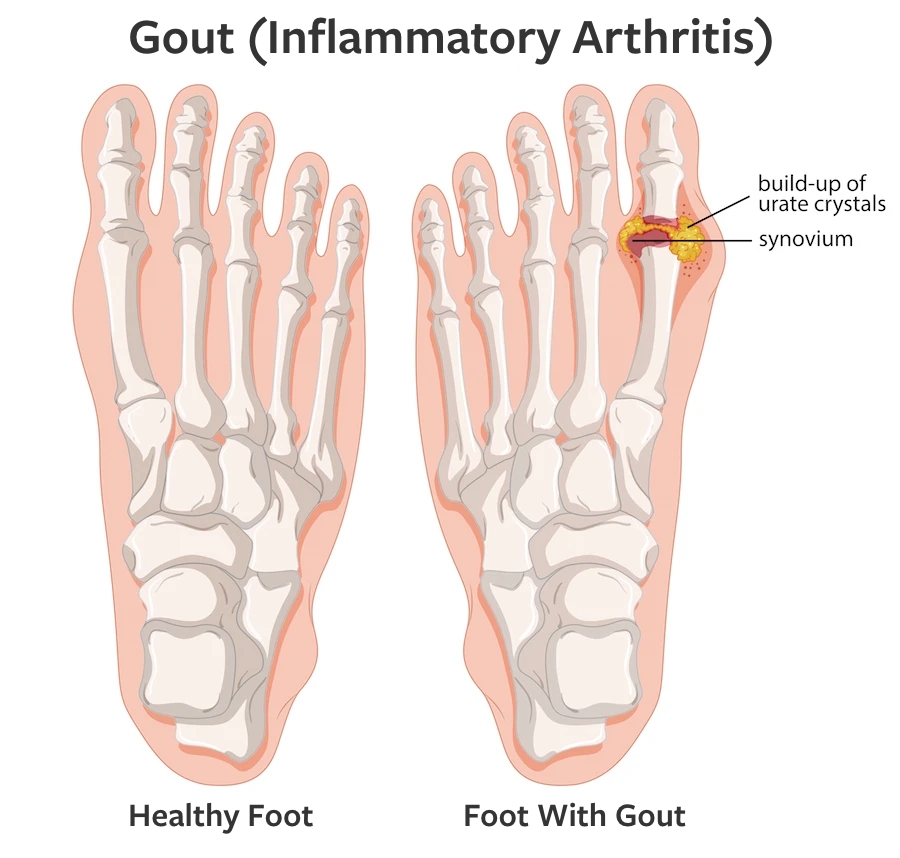
If you are experiencing pain around your big toe joint near your toenail, this could be the first sign of gout. Patients who have pain in other areas of their body are at greater risk for flare-ups in their feet. Whether you have localized or extended discomfort, there are ways to limit the problems caused by this condition.
Symptoms of Foot Gout
Attacks of gout normally occur at night, with pain severe enough to wake sufferers from sleep. The symptoms include:
- Swelling
- Tenderness
- Redness
- Sharp pain in the big toe.
The first attack will be very painful for the first 4-12 hours and gradually subside. Some Plano patients have joint discomfort that can last up to a few weeks and limit their range of motion.
Gout Prevention for Patients
Gout is a condition that can be aggravated by lifestyle choices such as the types of food you eat and the beverages you drink. Food and drink high in uric acid can raise your levels and create crystals that cause pressure, stiffness, and pain in your joints.
Reduce Red Meat
Red meat is one contributor to an increase in uric acid. Like many other animal proteins, red meat contains purines. Purines occur naturally in your body, but adding red meat to the mix means that your body must produce even more uric acid to break down these purines. Cutting out red meat is one of the first recommendations that your podiatrist is likely to make.
Lower Alcohol Consumption
Alcohol can make it more difficult for your body to get rid of uric acid. This can result in the type of build-up that causes gout attacks. It’s not always necessary to eliminate all alcohol from your diet; your podiatrist may instead suggest a lower intake. Moderation can make a significant impact in your comfort over time.
Avoid Foods with High-fructose Corn Syrup
The Mayo Clinic cites that fructose is known to increase uric acid. You may find high-fructose corn syrup in a variety of beverages; reading the label will help you know what drinks can contribute to your symptoms and which you should avoid.
Treating Gout
Board Certified Dr. Rachel Verville is a podiatrist and foot surgery professional in Frisco, Texas. She regularly advises gout patients about how to manage their condition.
Typically, Dr. Verville will recommend that you change your diet first to eliminate sources that can cause an increase in uric acid. Cutting down on red meat, alcohol, high-fructose corn syrup, and other foods will make a big improvement in your gout symptoms.
Dr. Verville may recommend additional treatment to manage symptoms by prescribing anti-inflammatory medication that improves the way your body deals with uric acid and the crystals that it forms. Follow-up visits with RNV Podiatry will track the reduction of your symptoms and progress over time.
Learn How Dr. Verville Diagnoses Foot Gout
Preventing Future Attacks
If caught early, your podiatrist can advise you on lifestyle changes to lower levels of uric acid in your body. Limiting the following may be enough to resolve problems with gout:
- Meat
- Seafood
- Alcohol
- Drinks sweetened with fructose
Proper diet combined with exercise will resolve most patients’ problems with gout within a few weeks or months. However, patients who have other medical conditions such as high blood pressure, diabetes, metabolic syndrome, heart or kidney disease are more likely to experience trouble and require medication to manage their gout.




